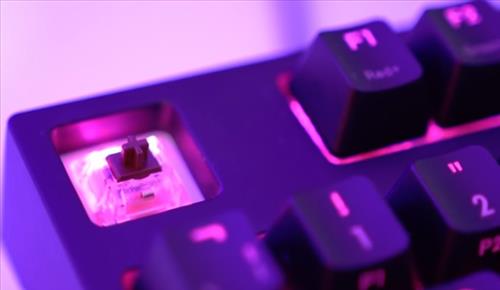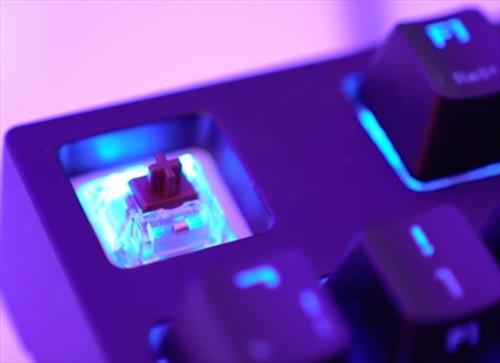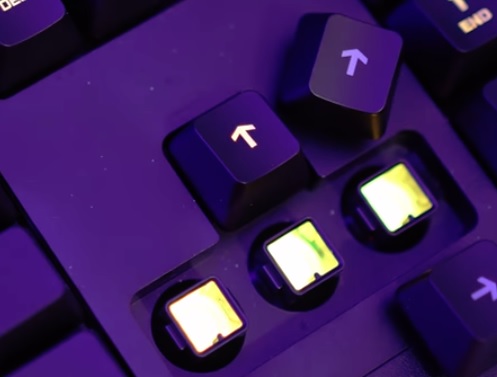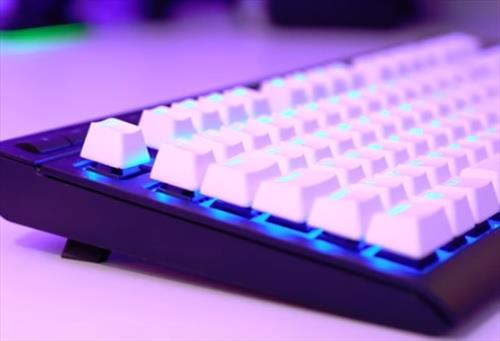- What is a Mechanical Keyboard?
- What are the Differences Between Mechanical Keyboards?
- Tactile and Linear Switches
- Types of Switches Available and Sound Examples
- Cherry MX Brown
- Cherry MX Red
- Buckling Springs
- Cherry MX Blue
- Cherry MX Green
What is a Mechanical Keyboard?
A mechanical keyboard uses physical switches instead of an electronic grid under the buttons to send a signal to a computer after a key has been pressed.

A mechanical switch can have an advantage over a standard keyboard electronic interface in some instances, such as gaming.
They are more rugged and can take a pounding that a standard keyboard wouldn’t be able to hold up too.
The very nature of it being a physical switch gives feedback to a user that can’t be matched with conventional keyboards.
Many people love them since they give feedback to the user in the form of clicks and how they react when a key is pressed.
Gamers use them since they can be used hard and keep going along with the immediate knowledge that a key is doing what it is supposed to.
Writers and typists like them since they can cut down on typos and can give an interaction that old writers experienced before modern keyboards came along.
What are the Differences Between Mechanical Keyboards?
The main difference between the average keyboard and mechanical keyboards is the switches that are used.

One type of switch will be easier to press for the person who types lightly, while another will be more solid for the typist that likes to press the keys harder.
Also, the sound the switches make is a factor. One type of switch will click more loudly than another type.
Which is best a user preference since mechanical switches vary depending on the pressure needed to initiate the switch and the sound it makes when pressed.
Tactile vs. Linear Switches
There are two different types of switches used in mechanical keyboards tactile and linear.

Tactile switches give more feedback to a user with more clicking and the feeling of the switch when pressed. A tactile switch uses what is called a tactile-bump to give a user feedback.
Linear switches provide less feedback to a user and are less clicky-sounding than Tactile.
All the mechanical switches will have roughly 4 mm of movement to the bottom of a switch and 2 mm of movement before the key touches the button.
Types of Switches Available and Sound Examples
Cherry MX Brown
The Cherry MX Brown switches are tactile switches. They are smooth and have a nice actuation point when the switch is pressed. They require 45-55 grams of force to press a key compared to a standard keyboard which can vary widely from 25-90 grams of force.
Cherry MX Red
The Cherry MX Red is a linear switch that is used a lot in gaming. The keys are soft when pressed, and double-taping a key quickly is easy with the Reds. They use 45 Grams of pressure to press a key. This type of keyboard gives less feedback to a user and doesn’t give as much of an audible click. They also don’t have a feeling that a key has been pressed, feeling mushy compared to a stiffer click.
Buckling Springs
This is the type of keyboard that was used in the 80s and 90s with all the old IBM 8088 computers. If you are old enough to remember the 80s and 90s, then you will likely love to have one as they bring back a lot of memories for some. These types of keyboards use a large spring under the keys to press them back up.
These require 65-70 Grams of force. Actuation is 2.3 mm and 3.7 mm until the switch bottoms out, so these keys are slightly closer together than other mechanical keyboards.
Cherry MX Blue
Cherry MX blue is the most common switch used with mechanical keyboards. They are tactile switches and make a clicking sound when pressed. If you like a click when pressing a key, then Blue is for you. Blue requires 50-60 grams of force.
Cherry MX Green
Cherry MX Green switches are tactile similar to Blue, but require more force to press a button, 80-100 Grams of force. Since more force is required to press a key, fewer accidental keys will be pressed. A person must be deliberate with this keyboard. Many gamers like this type of switch since it has roughly the same key pressure as a game controller and is built to take a pounding.
Cherry MX Clear
The Cherry MX Clear switch is basically a stiffer Brown. 55-60 grams of force. These are becoming harder to find. We don’t have any Cherry MX Clear samples yet.
Cherry MX Black
Basically a stiffer MX Red switch with 60-80 Grams of pressure, a linear switch, and easy to double tap. We don’t have any Cherry MX black samples yet.

0 Commentaires